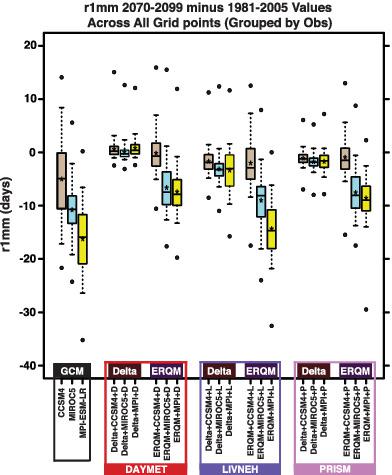当前位置:
X-MOL 学术
›
Int. J. Climatol.
›
论文详情
Our official English website, www.x-mol.net, welcomes your
feedback! (Note: you will need to create a separate account there.)
Statistically downscaled precipitation sensitivity to gridded observation data and downscaling technique
International Journal of Climatology ( IF 3.5 ) Pub Date : 2020-07-09 , DOI: 10.1002/joc.6716 Adrienne M. Wootten 1 , Keith W. Dixon 2 , Dennis J. Adams‐Smith 2, 3 , Renee A. McPherson 1
International Journal of Climatology ( IF 3.5 ) Pub Date : 2020-07-09 , DOI: 10.1002/joc.6716 Adrienne M. Wootten 1 , Keith W. Dixon 2 , Dennis J. Adams‐Smith 2, 3 , Renee A. McPherson 1
Affiliation

|
Future climate projections illuminate our understanding of the climate system and generate data products often used in climate impact assessments. Statistical downscaling (SD) is commonly used to address biases in global climate models (GCM) and to translate large‐scale projected changes to the higher spatial resolutions desired for regional and local scale studies. However, downscaled climate projections are sensitive to method configuration and input data source choices made during the downscaling process that can affect a projection's ultimate suitability for particular impact assessments. Quantifying how changes in inputs or parameters affect SD‐generated projections of precipitation is critical for improving these datasets and their use by impacts researchers. Through analysis of a systematically designed set of 18 statistically downscaled future daily precipitation projections for the south‐central United States, this study aims to improve the guidance available to impacts researchers. Two statistical processing techniques are examined: a ratio delta downscaling technique and an equi‐ratio quantile mapping method. The projections are generated using as input results from three GCMs forced with representative concentration pathway (RCP) 8.5 and three gridded observation‐based data products. Sensitivity analyses identify differences in the values of precipitation variables among the projections and the underlying reasons for the differences.Results indicate that differences in how observational station data are converted to gridded daily observational products can markedly affect statistically downscaled future projections of wet‐day frequency, intensity of precipitation extremes, and the length of multi‐day wet and dry periods. The choice of downscaling technique also can affect the climate change signal for variables of interest, in some cases causing change signals to reverse sign. Hence, this study provides illustrations and explanations for some downscaled precipitation projection differences that users may encounter, as well as evidence of symptoms that can affect user decisions.
中文翻译:

对栅格化观测数据和降尺度技术的统计降尺度降水敏感性
未来的气候预测将阐明我们对气候系统的理解,并生成经常在气候影响评估中使用的数据产品。统计缩减(SD)通常用于解决全球气候模型(GCM)中的偏差,并将大规模的预测变化转换为区域和地方尺度研究所需的更高空间分辨率。但是,按比例缩小的气候预测对按比例缩小过程中所做的方法配置和输入数据源选择很敏感,这可能会影响预测对特定影响评估的最终适用性。量化输入或参数的变化如何影响SD生成的降水预测对于改善这些数据集及其对研究人员的使用至关重要。通过对一套系统设计的18个统计数据进行分析,该数据集对美国中南部的未来日降水量进行了统计缩减,本研究旨在改善对影响研究人员的指导。研究了两种统计处理技术:比率增量缩减技术和等分位数映射方法。使用来自具有代表性浓度路径(RCP)8.5的三个GCM和三个基于观测的网格化数据产品的输入结果来生成预测。敏感性分析可确定这些预测之间降水变量值的差异以及差异的潜在原因。结果表明,观测站数据如何转换为网格化的每日观测产品的方式差异可能会显着影响未来湿天频率,极端降水强度以及多天干湿时间长度的统计缩减规模。降尺度技术的选择还会影响目标变量的气候变化信号,在某些情况下会导致变化信号反转符号。因此,本研究为用户可能遇到的某些降尺度的降水量预测差异提供了说明和解释,以及可能影响用户决策的症状证据。降尺度技术的选择还会影响目标变量的气候变化信号,在某些情况下会导致变化信号反转符号。因此,本研究为用户可能遇到的某些降尺度的降水预测差异提供了图解和解释,以及可能影响用户决策的症状证据。降尺度技术的选择还会影响目标变量的气候变化信号,在某些情况下会导致变化信号反转符号。因此,本研究为用户可能遇到的某些降尺度的降水量预测差异提供了说明和解释,以及可能影响用户决策的症状证据。
更新日期:2020-07-09
中文翻译:

对栅格化观测数据和降尺度技术的统计降尺度降水敏感性
未来的气候预测将阐明我们对气候系统的理解,并生成经常在气候影响评估中使用的数据产品。统计缩减(SD)通常用于解决全球气候模型(GCM)中的偏差,并将大规模的预测变化转换为区域和地方尺度研究所需的更高空间分辨率。但是,按比例缩小的气候预测对按比例缩小过程中所做的方法配置和输入数据源选择很敏感,这可能会影响预测对特定影响评估的最终适用性。量化输入或参数的变化如何影响SD生成的降水预测对于改善这些数据集及其对研究人员的使用至关重要。通过对一套系统设计的18个统计数据进行分析,该数据集对美国中南部的未来日降水量进行了统计缩减,本研究旨在改善对影响研究人员的指导。研究了两种统计处理技术:比率增量缩减技术和等分位数映射方法。使用来自具有代表性浓度路径(RCP)8.5的三个GCM和三个基于观测的网格化数据产品的输入结果来生成预测。敏感性分析可确定这些预测之间降水变量值的差异以及差异的潜在原因。结果表明,观测站数据如何转换为网格化的每日观测产品的方式差异可能会显着影响未来湿天频率,极端降水强度以及多天干湿时间长度的统计缩减规模。降尺度技术的选择还会影响目标变量的气候变化信号,在某些情况下会导致变化信号反转符号。因此,本研究为用户可能遇到的某些降尺度的降水量预测差异提供了说明和解释,以及可能影响用户决策的症状证据。降尺度技术的选择还会影响目标变量的气候变化信号,在某些情况下会导致变化信号反转符号。因此,本研究为用户可能遇到的某些降尺度的降水预测差异提供了图解和解释,以及可能影响用户决策的症状证据。降尺度技术的选择还会影响目标变量的气候变化信号,在某些情况下会导致变化信号反转符号。因此,本研究为用户可能遇到的某些降尺度的降水量预测差异提供了说明和解释,以及可能影响用户决策的症状证据。











































 京公网安备 11010802027423号
京公网安备 11010802027423号